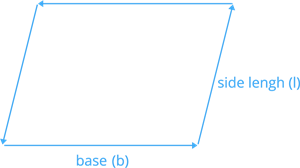UPSKILL MATH PLUS
Learn Mathematics through our AI based learning portal with the support of our Academic Experts!
Learn moreTo calculate the area of a parallelogram, multiply the base times 'b' the height 'h'.

Area of parallelogram A = b × h square units.
Example:
A parallelogram has a base of 6 m and 3 m height, what is its area?
Let the base b= 6m and the height h= 3m.
Area A = b × h = 6m × 3m =18m².
To calculate the base of the parallelogram, divide area 'A' by height 'h'.
Base of parallelogram b = A/h unit.
Example:
A parallelogram has an area of 64 m² and its height 4 m, what is its base?
Let the area A= 64m² and the height h= 4m.
Base = .
To calculate the height of the parallelogram, divide area 'A' by base 'b'.
Height of parallelogram h = A/b unit.
Example:
A parallelogram has an area of 64 m² and 16 m base, what is its height?
Let the area A= 64m² and the height h= 16m.
Height = .
Where 'A' is denoted as area, 'b' is denoted as the base and 'h' is denoted as the height.
To calculate the perimeter of a parallelogram, multiply 2 times the (base + side length).

Perimeter of parallelogram P = 2 (b + l).
Where 'b' is denoted as the base, and 'l' is denoted as the side length.
Example:
A parallelogram has a base of 5 m and 3 m length, what is its perimeter?
Here the base b= 5m and the side length l= 3m.
Perimeter =2(b + l)
=2(5+3)
=2(8)
=16m.